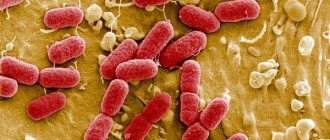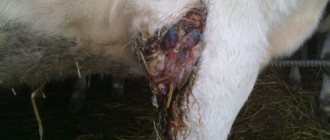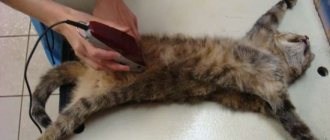Pulmonary edema is a pathological condition in which the liquid part of the blood sweats out and accumulates in the intercellular space (interstitium) of the lungs or pulmonary alveoli.
The lungs are the main organ of the respiratory system, where gas exchange occurs. The right and left lungs are formed by bronchi, bronchioles, alveolar ducts and alveoli surrounded by connective tissue. Direct gas exchange in the lungs occurs in the acini. It is the functional unit of the lung, represented by bronchioles, alveolar ducts and alveoli. Alveoli are vesicles through which capillaries carrying blood pass. The inner surface of the alveoli is lined with specific epithelial cells - respiratory epithelium. Its cells are closely adjacent to the cells of blood vessels, which makes it possible to enrich the blood with oxygen.
Causes of pulmonary edema and what happens
Pulmonary edema can develop through 3 main mechanisms:
- Increased hydrostatic pressure
in the vessels of the pulmonary circulation (when, with an acute increase in pressure in the capillary, its permeability is disrupted and the liquid part of the blood enters the interstitial tissue of the lung). This occurs with various heart defects, cardiomyopathy, endocarditis and other heart diseases, as well as with volume and rapid intravenous infusions. - Decrease in oncotic pressure of the blood
(in this case, a difference arises between the oncotic pressure of the blood and the oncotic pressure of the intercellular fluid, and in order to equalize this difference, the fluid from the vessel enters the extracellular space - the interstitium). This mechanism develops with hypoproteinemia. - Increased permeability of capillary-alveolar membranes
(as a result of any damage, the protein structure of the capillary-alveolar membranes is disrupted with the release of fluid into the interstitial space). This process is observed in pneumonia, various intoxications, and disseminated intravascular coagulation syndrome.
The development of pulmonary edema can also be promoted by renal failure, snake bite, heat stroke, electrical trauma, and traumatic brain injury.
What it is
The process of breathing in animals, as in humans, occurs with the participation of alveoli - peculiar bubble formations in the lungs, intertwined with a network of blood vessels. Under normal conditions, the alveoli of the lungs during inhalation are filled with oxygen entering the blood, which then carries it to the brain, nourishes the heart and tissues. When you exhale, exhaust air containing carbon dioxide is released through the alveoli.
In pulmonary insufficiency (edema), for various reasons, transudate (edematous fluid) and the liquid part of the blood enter the alveoli - infiltration. A sharp decrease in the working volume of the lungs disrupts the breathing process and leads to progressive oxygen starvation of the body.
Prevention issues and consequences
All diseases that may be accompanied by hyperemia (fullness of blood) of the lungs require careful monitoring in order to prevent the accumulation of fluid in the lung tissue.
The consequences of the disease are varied. There are prerequisites for damage to literally all internal organs due to oxygen starvation. Hypoxia is especially dangerous for the brain, heart muscle, liver and kidneys.
Oxygen therapy
After swelling, there is a high chance of developing other pulmonary diseases:
- atelectasis - flattening of the alveoli, as a result of which they lose the ability to fill with air,
- pneumosclerosis - the walls of the alveoli lose their elasticity, gas exchange is disrupted, lung tissue is replaced by connective tissue,
- congestive pneumonia is a secondary pathology leading to impaired blood outflow due to insufficiency of the left ventricle of the heart,
- emphysema - overflow of the bronchi with air and its penetration into the interpulmonary space.
Pulmonary hyperemia is an extremely dangerous and serious disease, in which any delay in providing first aid can cost the pet’s life.
Author of the article: Marina Nikolaevna Chuprina, veterinarian, parasitologist
Pulmonary edema is the accumulation of fluid in the intercellular space or alveoli of the lungs as a result of pathological processes. Cats, like most creatures, cannot live without oxygen. If the functioning of the lungs is impaired, its supply decreases sharply, inhibiting the functioning of the entire body and can lead to death.
Causes of the disease
Pulmonary failure in cats almost always develops as a complication of heart disease, but it can also have a different, non-cardiogenic nature.
Cardiogenic pulmonary edema
The most common cause of pulmonary edema is progression of heart failure in cats. Heart failure develops due to disruption of the left ventricle of the heart. This provokes pathology of the pulmonary circulation and swelling in various organs and tissues, including the lungs. Cardiogenic edema accompanies the following diseases:
- cardiomyopathy;
- aortic insufficiency;
- mitral stenosis of the heart;
- pulmonary embolism;
- myocarditis;
- hypertension;
- infective endocarditis.
Cardiogenic pulmonary edema in cats is characterized by a gradual filling of the alveoli with fluid, an increase in oxygen starvation of tissues, turning into asphyxia. In this case, in order to save the animal, resuscitation measures cannot be avoided.
Non-cardiogenic edema
Infectious and non-infectious ailments that may be complicated by pulmonary insufficiency are:
- diseases of the respiratory system: pneumonia, bronchial asthma, tuberculosis, chest injuries, inhalation of volatile toxic substances;
- diseases of the excretory system: nephritis, renal failure;
- Gastrointestinal diseases: pancreatitis, intestinal obstruction, volvulus;
- diseases of the nervous system: encephalitis, meningitis, brain tumors, reaction to anesthesia after sterilization or castration;
- complications of infectious diseases: influenza, inflammation of the upper respiratory tract, plague;
- severe allergic reactions.
Predisposition to disease
Pulmonary edema of a cardiogenic nature more often occurs in cats of certain breeds that have a hereditary tendency to cardiovascular pathologies. This breed defect is inherent in many artificially bred cat breeds:
- sphinxes;
- Maine Coon;
- the British;
- Scottish Fold;
- Persian and representatives of other breeds.
Kittens more often suffer from traumatic pulmonary edema. The pathology develops in them after chest injuries, to which they are very susceptible.
There is no difference in the incidence of this pathology between males and females.
Forecast
Pulmonary edema in cats is a very dangerous condition that develops rapidly and can be fatal.
Cat owners should be prepared for such developments and understand that in this case time is everything.
The sooner a cat is shown to specialists, the sooner it receives first aid, the higher its chances of survival.
In a hospital setting, there are all the necessary tools for diagnosing and assisting an animal: x-rays, an oxygen chamber, injections and medications.
Competent intensive therapy at the initial stage of the disease is a guarantee of success. It is unacceptable to treat pulmonary edema on your own - it can kill your beloved pet.
Types of disease
Based on the rate of progression of symptoms, several types of disease are distinguished:
- Lightning fast - has rapid development, leading to rapid death.
- Acute - characterized by a high rate of development. Symptoms increase over several hours. In this case, prompt treatment is the only way to save the animal.
- Subacute - has a wave-like development. Periods of increasing symptoms are followed by periods of subsiding.
- Protracted - has erased symptoms. Characteristic of chronic pathologies.
What complications can there be?
In a kitten, pulmonary edema is more severe than in an adult animal. This is due to a weak immune system, so not only kittens, but also older pets are at risk. They often experience the following complications:
- emphysema;
- pneumonia;
- fibrosis of the lung tissue and collapse of the pulmonary lobe (atelectasis);
- sepsis;
- acidosis;
- heart failure.
If treatment is delayed, the cause of death is airway obstruction or cardiogenic shock. Unpleasant consequences can be avoided with the help of prevention, so do not neglect the basic recommendations.
Symptoms of the disease
In cats, symptoms of pulmonary edema include signs of oxygen deprivation. Their onset may be preceded by a characteristic state of the animal, indicating a deterioration in health. This is anxiety, hoarse cough, refusal to eat, pallor of the mucous membranes.
With an increase in oxygen deficiency in the tissues, the animal begins to suffocate. The state of lack of air is determined by the specific behavior of the cat:
- heavy breathing with an open mouth and protruding tongue;
- a position in which it is easier to breathe: paws widely spaced, neck elongated and head lowered;
- cold paws;
- bluish mucous membranes of the lips and nose;
- abdominal breathing.
Causes of the condition in cats
But for what reasons does pulmonary edema develop in cats? Is there any way to protect your four-legged friend? How to correctly recognize it and help a purr with such a severe pathology? There are many causes of pulmonary edema in cats. Let's look at all the possible options.
Dehydration
No matter how strange it may sound, pulmonary edema in a cat can develop both due to starvation and due to poisoning. In this case, a huge amount of water leaves through the gastrointestinal tract, and the pet becomes dehydrated.
As a result, the oncotic pressure decreases, and the liquid fraction begins to sweat out of the blood. It is this that accumulates in the lungs, causing swelling. In addition, problems with the kidneys and liver lead to a decrease in oncotic pressure.
Increased permeability of blood vessels (distress syndrome) can aggravate the condition. It develops due to poisoning with serious poisons, medications, smoke and toxic fumes, and due to previous injuries (including pulmonary injuries). Many diseases of internal organs (even pancreatitis) can lead to the vessel wall becoming less durable and capable of allowing fluid to pass through its surface into the intercellular space.
Heart failure can also cause pulmonary edema in a cat. The pet may have problems with the heart itself, or the purr is constantly tired (the heart is almost worn out). Therefore, if you already know about this illness in your pet, keep in mind that he is at risk. And for you, this is another reason to monitor him more carefully.
Other reasons
Tumors and other neoplasms can also be causes, but relatively less often than those mentioned above.
In determining the causes of pulmonary edema, there are provoking factors and direct mechanisms for the occurrence of the disease.
According to the mechanisms of occurrence there are:
- Cardiogenic. Occurs against the background of acute or chronic heart failure. The most common causes are heart defects, arterial hypertension and cardiosclerosis.
- Non-cardiogenic – quite rare in cats. Usually associated with blockage of the upper respiratory tract - swelling or paralysis of the larynx, abscesses, foreign bodies, as well as anaphylactic shock and gas poisoning.
Provoking factors include various chest injuries, concussions and electrical injuries. This also includes the entry of vomit into the respiratory tract.
Another reason for the development of the disease can be inflammatory infectious processes.
Which develop directly in the tissues of the lungs - pneumonia, tuberculosis, carnivore plague.
Neoplasms are also one of the reasons for the development of edema. As well as diseases of other organs and systems - kidneys, liver and poisons.
We suggest you read: Is it possible to castrate an adult cat? Possible consequences
Pulmonary edema in cats occurs due to the overflow of pulmonary capillaries with blood, accompanied by the release of the liquid part into the surrounding tissues. By its nature, the disease can be cardiogenic, that is, arising against the background of heart disease, and non-cardiogenic.
Heart reasons
Cardiogenic edema, as already noted, is the result of heart failure. As a rule, with weak functioning of the left ventricle (one of the parts of the heart), the work of the pulmonary circulation is disrupted, which leads to stagnation of blood in the lungs and subsequent leakage of fluid into the surrounding tissues.
This state can be compared to a porous sponge: up to a certain point, it swells and absorbs water without leaving a trace, but there comes a moment when there is no space left and the water flows out.
For cardiogenic causes, edema begins in the lower sections, but gradually the process moves to the bronchi.
It is worth noting that the prognosis for pulmonary edema is unfavorable, especially if it is caused by a heart defect.
Other factors
Non-cardiogenic causes of hyperemia (another name for the disease) are the following:
- inhalation of hot air;
- inhalation of potent gases with a pungent odor (for example, prolonged exposure to high concentrations of ammonia vapor will easily cause swelling);
- lobar pneumonia;
- heat or sunstroke;
- bacterial or viral infections that affect the lungs (pasteurellosis, canine distemper, etc.);
- exposure to electric current;
- brain injuries due to an unsuccessful fall or blows;
- development of the septic process;
- taking certain potent medications in dosages significantly higher than recommended;
- renal failure, when the protein concentration in the blood sharply decreases;
- allergy;
- bronchial asthma;
- malignant tumors in the lungs that interfere with normal blood supply.
It is important to understand that pulmonary edema is a serious and very severe pathology, often ending in the death of a cat.
Pulmonary edema in a cat is accompanied by coughing and difficulty breathing.
An animal suffering from heart defects, especially if it is already of advanced age, is at risk. Therefore, any self-respecting owner of a sick pet should learn to recognize the signs of impending danger. And they are:
- the cat suddenly takes a forced pose: stands with its forelimbs widely spaced and its head bowed, thereby trying to inhale as much air as possible, its sides are greatly inflated;
- paws become cold;
- after a while the animal falls exhausted on its side and never gets up again;
- the mucous membranes of the mouth turn pale or become cyanotic;
- the animal has difficulty breathing, coughs heavily, and produces pinkish sputum;
- seething, bubbling cough;
- foamy discharge may occur from the nose and mouth;
- tongue hangs out;
- the work of the heart weakens, the pulse first quickens, and then becomes weak and intermittent;
- death occurs as a result of paralysis of the respiratory center.
The behavior of the animal also changes:
- firstly, he is scared, and fear can be read in everything;
- secondly, the lack of oxygen confuses the consciousness, the gaze becomes crazy, and then empty and unseeing;
- thirdly, the cat stops reacting to its surroundings and does not recognize its owners at all.
Despite the fact that edema is an acute and rapidly developing condition, you can notice the approaching danger in advance if you carefully observe your pet and its behavior. Typically, within a few days the breathing rhythm may become disrupted:
- the animal breathes with its stomach (the abdominal stacks shake) or through the mouth;
- the number of rhythmic inhalations and exhalations per minute increases significantly (more than 40);
- the breathing itself is wheezing and labored with periodic hacking coughing.
It is clear that such symptoms do not always indicate developing edema, but the time to ring the bells has already come. It is better to play it safe and take the animal for diagnostics to a clinic, where they will order an x-ray and perform auscultation (in other words, they will listen to the lungs using a special device) and check the functioning of the heart.
Moreover, it is better to film a cough and an altered state on video - fortunately, now almost everyone has a phone with a camera. This will help the veterinarian see the progression of the disease over time, decide on the prescription of additional diagnostic tests and speed up the diagnosis.
Important! It is much easier to cure a process that is caught in a timely manner than to try to correct a neglected and altered condition, which is most often no longer compatible with life.
There is no need to console yourself with excessive hopes: in most cases, pathology is regarded as a dying condition! There is a chance to rescue an animal from the dead only if non-cardiogenic edema occurs.
Even if it was possible to stop the development of the process in the case of cardiac causes, the likelihood of a recurrence of the attack is too high.
If your cat has pulmonary edema, your cat needs immediate medical attention.
The disease requires immediate intervention from specialists; attempts to help the pet on your own will significantly aggravate the condition and hasten the approach of death.
All that the owner can do (provided that the swelling occurs due to heart failure) is to inject a solution of furosemide intramuscularly - a diuretic drug helps remove fluid from the body - and urgently go to the veterinary clinic.
Important! Using diuretics unless prescribed by your veterinarian is still not recommended.
In case of hyperemia, resuscitation cannot be avoided; further observation in a hospital is required. It is not possible to cure an animal with a telephone consultation!
When going to the hospital, it is important to try not to irritate the animal, especially at the time of the attack, so that the situation does not become even more complicated. There is no need to fuss, run, sob, cry - the cat feels all this and, naturally, gets stressed. And stress, as we know, does not lead to good things.
The resuscitation scheme usually includes the use of an oxygen cushion (chamber), in some cases tracheotomy and the administration of:
- diuretics (diuretics) to remove accumulated water in the lungs;
- defoamers;
- vasodilators;
- cardiac drugs to stabilize the heart;
- bloodletting;
- novocaine blockade of sympathetic nodes.
After the crisis has passed, the animal is placed in a cool, well-ventilated room (but ventilation does not mean a draft) and symptomatic treatment is applied: expectorants, antibiotics, etc. It is very important to determine the cause of the edema and eliminate it.
Most cases of pulmonary hyperemia end in the development of complications, which also need to be, if not prevented, then at least correctly diagnosed and treated. The most common consequences include:
- pneumonia;
- collapse of the alveoli (atelectasis);
- overgrowth of the alveoli with connective tissue (pneumosclerosis);
- emphysema - overfilling of the alveoli with air followed by their rupture.
In addition, prolonged oxygen starvation negatively affects almost all organs, especially the cells of the brain and kidneys.
For cats with heart problems, constant monitoring of the state of the cardiovascular system and heart function is necessary. It is especially important to constantly monitor animals at risk:
- obese people;
- with confirmed caryomyopathy;
- leading a “sofa” lifestyle;
- having relatives with heart problems;
- British, Scots, Macoons, Persians, Abyssinians and Sphynxes - those breeds that most often suffer from heart disease;
- drowsy and easily overtired.
First aid before going to the veterinary clinic
If there are signs of pulmonary edema, immediate assistance to the animal is very important, since it determines whether resuscitation will be successful. Before delivering the cat to the clinic, it is necessary to make the breathing process as easy as possible for her using improvised methods:
- give an injection of a diuretic (Furosemide);
- open the windows or take the cat out into the fresh air;
- provide the animal with complete rest and limit physical activity;
- do not disturb or take any forceful action towards him;
- deliver to the clinic as quickly as possible;
- During transportation, it is advisable to place the animal on its side.
If first aid is provided correctly, then subject to a professional approach to the choice of treatment method, there is hope that the animal will recover.
First aid
After alarming symptoms occur, it is necessary to take your pet to the veterinarian as soon as possible. Until this moment, the owner can only alleviate the animal’s condition by slowing down the development of pathology until medical assistance is provided.
What to do first
What to do if your dog develops pulmonary edema:
- Place the dog on its side and limit its mobility. Activity is accompanied by an impressive consumption of oxygen, which is already in short supply.
- Try to replenish your air supply by opening all the windows in the room or car.
- Promptly remove any discharge that comes from your nose or mouth.
Try to calm your pet down with gentle words and strokes. Excessive excitement will only worsen his condition.
Elimination of shock
Shock is eliminated by artificial ventilation, or tracheostomy, which involves inserting a special tube into the trachea. Oxygen may also be given intravenously. All these procedures increase the pulmonary surface, normalizing the functioning of the pulmonary circulation. The alveoli are again saturated with oxygen, so for complete recovery all that remains is to eliminate the cause of the pathology that has arisen.
Prohibited actions
Pets are very good at picking up on their owners' emotions, so try not to panic and act judiciously. Do not try to make your pet feel better with diuretics unless advised by your veterinarian. With severe dehydration, they can aggravate the existing situation, accelerating the increase in symptoms.
If the attack occurred at night, do not wait for the morning to come. Many veterinary clinics operate around the clock and accept patients in serious condition without an appointment.
Diagnosis of the disease
Diagnostic procedures should be as prompt as possible, since suffocation can progress rapidly. Sometimes it is advisable to start treatment procedures in parallel with diagnostics, so as not to miss time. Basic diagnostic measures:
- A detailed survey of the owner about the behavior and well-being of the animal since the moment of illness.
- External examination and auscultation (listening) of the lungs and heart.
- X-ray examination of the chest. Based on the pulmonary pattern, one can determine the nature of the pathology, since areas of the lungs that do not take part in the breathing process and the level of fluid in the alveoli are visible. Pathological changes in the heart muscle are also determined. X-rays also help to carry out differential diagnosis, which makes it possible to separate the disease from other pathologies of the heart and respiratory system.
- Ultrasound of the heart is prescribed if a cardiogenic origin of the disease is suspected, to determine how much the contractility of the left ventricle is altered.
- An electrocardiogram provides information about the presence of ventricular hypertrophy, arrhythmias and ischemia of the heart muscle.
- A general and biochemical blood test will complement the picture of the disease with a number of clinical signs.
Diagnostics in a veterinary clinic
To make a diagnosis, it is necessary to listen to the chest and check the function of the heart. The veterinarian determines the presence of extraneous noises, respiratory rate and heart rhythm. A four-legged patient must undergo a chest x-ray to identify pathological changes.
The exact cause of fluid stagnation will be determined with the help of additional studies: ultrasound, pleural puncture, analysis of blood clotting and its gas composition. The latter method is very informative for pulmonary artery thrombosis.
Treatment of the disease
Treatment of pulmonary edema begins with resuscitation measures designed to support the cat’s life. First of all, this is oxygen therapy, which consists of forcing the cat to breathe through a special mask where oxygen is supplied or placing it in an oxygen chamber for a certain time.
If the cause of pulmonary insufficiency is a foreign body or vomit entering the respiratory tract (aspiration), then they are removed by tracheostomy (extending the trachea).
The main treatment consists of drug therapy:
- getting rid of swelling and excess fluid in tissues - diuretics, diuretics (Furosemide);
- normalization of heart function - drugs that relieve heart failure and affect tissue metabolism (Carboxylase);
- decreased pressure in the pulmonary circulation - ganglion blockers (Bromide, Trimetaphan);
- stimulation of breathing - drugs that stimulate the parts of the brain responsible for breathing (Sulfocamphocaine);
- relieving inflammation - antihistamines (Dexamethasone);
- If pulmonary edema occurs in a cat due to a bacterial infection, then treatment with antibiotics is started.
After the acute condition has been relieved, therapy for the underlying disease begins, during which medications of various types are used, according to indications, depending on the nature of the disease.
Treatment of pulmonary edema and associated diseases should only take place in a hospital, since the serious condition of the animal requires constant medical supervision.
How to treat pulmonary edema in cats and dogs
Treatment includes:
- limiting the physical activity of the animal,
- minimizing stress,
- oxygen therapy (oxygen inhalation),
- drug support.
It is necessary to prescribe diuretics (furosemide, mannitol), glucocorticoids (dexamethasone, prednisolone), in some cases it is advisable to use sedatives (acepromazine). The use of vasodilators (nitroglycerin) and bronchodilators (aminophylline) is also indicated.
For non-cardiogenic pulmonary edema, treatment of the underlying disease is carried out, in particular treatment of hypoproteinemia. These measures are aimed at relieving respiratory failure, correcting increasing oxygen deprivation, and preventing shock.
Intensive therapy for pulmonary edema should be carried out until the animal’s condition is completely stabilized. Most often, such patients require inpatient observation for constant monitoring, the possibility of additional examinations and resuscitation measures in case of deterioration.
Forecasts
Recovery and prognosis depend on the underlying cause of pulmonary edema. On average, recovery occurs most often within 24-72 hours and then does not require special therapy. In severe cases, the so-called respiratory distress syndrome , which leads to the death of the animal.
Timely seeking help for animals with symptoms of dyspnea and immediate assistance to such patients is necessary to prevent complications and improve prognoses in the treatment of this condition.
Symptoms
The presence of fluid in a cat's lungs can be suspected by certain manifestations. The main symptoms of this pathological condition are
:
- decreased reactions to external stimuli;
- pallor of mucous membranes;
- heavy, complicated breathing, in which gurgling sounds are clearly audible;
- intense cough with pink sputum;
- sticking out tongue when coughing;
- increased pulse, which gradually becomes weak;
- coldness of paws;
- unsteadiness of gait.
As soon as symptoms of fluid in a cat's lungs are noticed, it should be taken to a veterinarian immediately.










